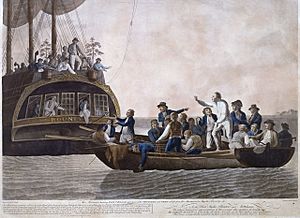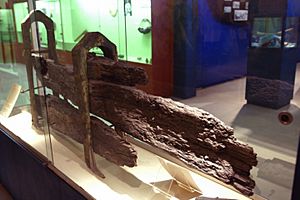Mutiny on the Bounty facts for kids
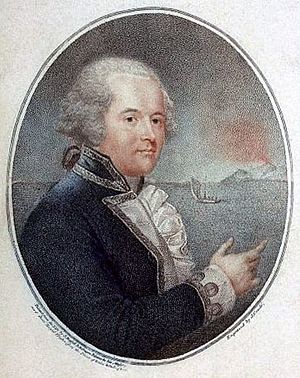
The Mutiny on the Bounty is a very famous story. It has inspired many books, movies, and songs. The HMS Bounty was a small sailing ship with three masts. It became famous when its crew (sailors) mutinied (took over the ship) on April 28, 1789. The captain of the Bounty was named William Bligh.
Contents
The Ship: HMS Bounty's Journey
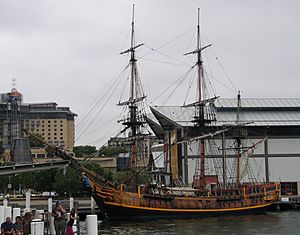
The Bounty was built in Hull, England in 1784. It was first called Bethia. In 1787, the ship was changed to carry breadfruit trees. Special heating and water systems were added to the cabins. This was to help the trees survive in cold weather. The British government wanted to grow breadfruit trees from Tahiti in Jamaica. This would provide cheap food for the workers on the sugar farms there.
The ship was quite small. It was about 90 feet (27.7 meters) long and 24 feet (7.4 meters) wide. Its tallest mast was 53 feet (16.1 meters) high.
Lieutenant William Bligh became the captain of the Bounty on August 16, 1787. The ship began its long trip to Tahiti on December 23, 1787. During the journey, Captain Bligh tried to sail around Cape Horn. He tried for over a month, but bad weather and strong winds stopped the ship. So, the Bounty turned around and took the longer route around the Cape of Good Hope.
Life in Tahiti and the Mutiny
The Bounty arrived in Tahiti on October 25, 1788. The ship had been at sea for ten months. The crew stayed on the island for five months. They collected 1015 breadfruit plants. The sailors enjoyed living in Tahiti. Many did not want to go back to England on another long journey. Fletcher Christian, one of the officers, became very fond of a Tahitian girl named Maimiti.
The Bounty left Tahiti on April 4, 1789, heading for Jamaica. On April 28, near the Friendly Islands, Fletcher Christian led the mutiny (take over). Captain Bligh and 18 loyal sailors were forced into a small boat. Christian and the Bounty then sailed back to Tahiti.
Christian and a small group of sailors, along with 11 Tahitian women and 6 Tahitian men, then traveled to the faraway Pitcairn Island. After they arrived, they took everything useful from the ship. A sailor named Matthew Quintal burned and destroyed the Bounty on January 23, 1790.
Pitcairn Island: A New Home
Pitcairn Island is a very remote island in the Pacific Ocean. People from Polynesia had known about the island and lived there a long time ago. But no one was living on Pitcairn when an English sailor, Philip Carteret, found it on July 2, 1767. He made a mistake and marked it on his map 200 miles from its real spot. This meant the people from the Bounty had the island to themselves.
There was a lot of conflict among the new settlers. Fletcher Christian, four other mutineers, and all six of the Tahitian men died in these conflicts. One of the four remaining mutineers died in an accident. Matthew Quintal was killed by the other two mutineers during a conflict.
When an American ship called Topaz visited the island in 1808, they found only one mutineer, John Adams, still alive. He was living with nine Tahitian women. In 1856, the British government moved all the islanders to Norfolk Island. Most stayed on Norfolk, but about 22 people eventually returned to Pitcairn. Their descendants still live there today. About half of Norfolk Island's population (around 1000 people) are descendants of the Bounty crew.
What Happened Next

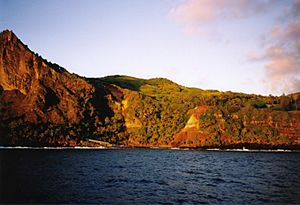
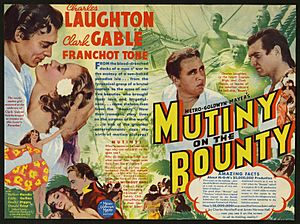
Lieutenant William Bligh managed to sail the small boat about 6500 km all the way back to Batavia. He returned to England and told the Admiralty about the mutiny on March 15, 1790.
On November 7, 1790, HMS Pandora was sent to Tahiti to look for the Bounty and to arrest the mutineers. The Pandora captured the mutineers who were still in Tahiti. However, they could not find the group hiding on Pitcairn Island. The Pandora ship was later wrecked on its way back to England.
Here is a summary of what happened to the crew of the Bounty:
- Two sailors died before the mutiny, one from an illness after an operation and another from disease.
- From the 19 people left in the small boat with Bligh, 12 made it back safely to England.
- One sailor was killed by local people on the island of Tofua during Bligh's journey.
- Several sailors died from illness after reaching Timor and Batavia.
- Seven sailors were forced to stay on the Bounty after the mutiny because there wasn't enough room in the small boat. They were later captured by HMS Pandora. Some were found innocent, others were pardoned, and one drowned when the Pandora sank.
- Some of the mutineers who stayed on Tahiti died before the Pandora arrived, often in conflicts.
- Three mutineers captured by the Pandora drowned when that ship was wrecked.
- Four mutineers survived the Pandora wreck and were taken to England for trial. Some were punished, while others were later released.
- On Pitcairn Island, most of the mutineers died in conflicts with each other or the Tahitian men. Only two of the mutineers who went to Pitcairn died peacefully: Edward Young from illness and John Adams from natural causes.
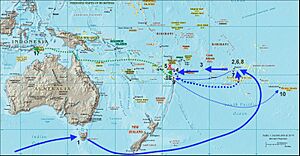
1. The Bounty arrives at Adventure Bay, Bruny Island, Tasmania on August 21, 1788.
2. The Bounty arrives at Tahiti on October 26, 1788. It leaves Tahiti on April 4, 1789.
3. Visits the island of Palmerston.
4. Visits the island of Tofua.
5. The mutiny happens on April 28, 1789.
Christian's travels with Bounty.
6. Tubai, then back to Tahiti on July 7, 1789.
7. Back to Tubai on July 16, 1789.
8. Returns to Tahiti on September 22, 1789, and leaves the next day.
9. Visits the island of Tongatabu on November 15, 1789.
10. Arrives at Pitcairn Island on January 15, 1790. The Bounty was burned on January 23, 1790.
Bligh's travel in the small boat
16. Tonga
17. Arrives at Batavia
Other Pages to Explore
Images for kids
-
A 1960 reconstruction of HMS Bounty
-
Matavai Bay, Tahiti, as painted by William Hodges in 1776
-
Fletcher Christian and the mutineers seize HMS Bounty on April 28, 1789. Engraving by Hablot Knight Browne, 1841
-
Map showing Bounty's movements in the Pacific Ocean, 1788–1790 Voyage of Bounty to Tahiti and to location of the mutiny, April 28, 1789 Course of Bligh's open-boat journey to Coupang, Timor, between May 2 and June 14, 1789 Movements of Bounty under Christian after the mutiny, from April 28, 1789 onwards
-
Tubuai, where Christian first tried to settle; the island is almost totally surrounded by a coral reef
-
Bounty Bay on Pitcairn Island, where HMS Bounty was burned on January 23, 1790
-
Descendants of the mutineers John Adams and Matthew Quintal on Norfolk Island, 1862. From Left to right:John Adams 1827–1897 son of George Adams; John Quintal 1820–1912 son of Arthur Qunital; George Adams 1804–1873 son of John Adams; Arthur Quintal 1795–1873 son of Matthew Quintal
See also
 In Spanish: Motín del HMS Bounty para niños
In Spanish: Motín del HMS Bounty para niños


